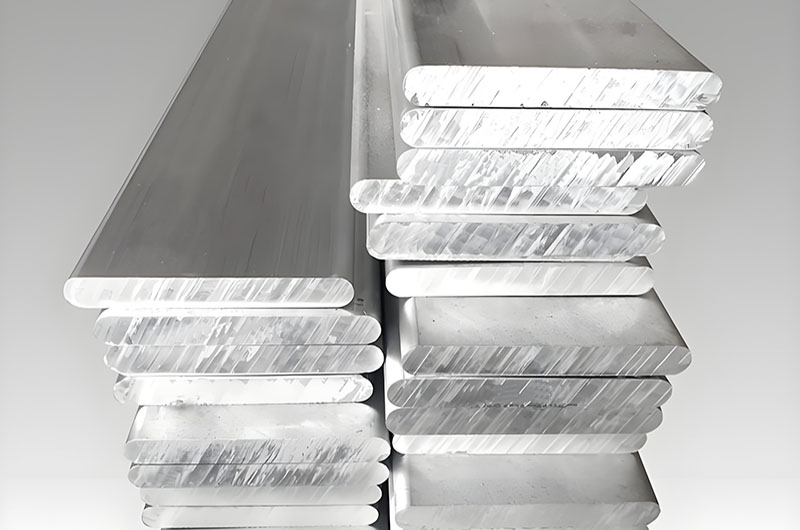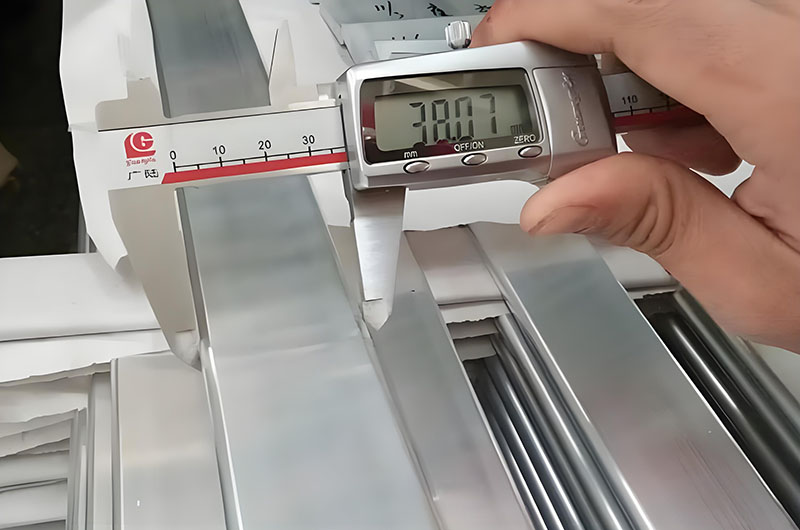6060 aluminum busbar is an electrical conductor made from 6060 alloy, belonging to the 6000 series (AlMgSi alloy). Busbars are used for efficiently distributing power in switchgear, distribution panels, industrial machinery, and other electrical systems. They are a lightweight, cost-effective alternative to copper, while still providing reliable conductivity and structural integrity.

6060 Aluminum Busbar Information
6060 Aluminum Busbar Material
6060 aluminum busbar is an aluminum alloy material based on aluminum-magnesium-silicon (Al-Mg-Si) alloy, belonging to the 6xxx series of aluminum alloys. It typically contains about 97.9–99.3% aluminum, with the main alloying elements being magnesium (0.35–0.5%) and silicon (0.3–0.6%). Traces of copper, iron, manganese, and chromium further improve its properties.
6060 Aluminum Busbar Electrical Conductivity and Thermal Conductivity
Although 6060 aluminum has lower electrical conductivity than copper, it still provides efficient power transmission, especially when designed with larger cross-sectional areas. Its thermal properties also support effective heat dissipation, which is critical in high current applications.
| Element | Composition |
| Si | 0.30-0.6% |
| Fe | 0.10-0.30% |
| Cu | Max. 0.10% |
| Mn | Max. 0.10% |
| Mg | 0.35-0.6% |
| Cr | Max. 0.05% |
| Zn | Max. 0.15% |
| Ti | Max. 0.10% |
| Others each | Max. 0.05% |
| Others total | Max. 0.15% |
| Al | Remainder |
Excellent Properties of 6060 Aluminum Busbar
Physical Properties
- Lightweight: With a density of about 2.7g/cm³, it is approximately 1/3 lighter than steel, making it suitable for weight-reduction applications.
- High Conductivity: Electrical conductivity can reach 50%–55% IACS (International Annealed Copper Standard), close to pure aluminum (61%), making it ideal for power transmission components.
- Excellent Thermal Conductivity: With a thermal conductivity of about 160–180 W/(m·K), it supports efficient heat dissipation design.
- Low-Temperature Resistance: It does not exhibit brittle fracture at low temperatures, making it suitable for aerospace and polar equipment.
| Density[kg/m] | 2700 |
| Melting range(°C) | 585-650 |
| Electrical conductivity [MS/m] | 28-34 |
| Thermal Conductivity [W/m.K] | 200-220 |
| Co-efficient of thermal expansion 10-6/K | 23.4 |
| Modulus of elasticity [GPa] | ~70 |
Chemical Properties
- Corrosion Resistance: The naturally occurring oxide film (Al₂O₃) on the surface resists atmospheric, freshwater, and weak acidic or alkaline environments, performing excellently in petrochemical applications.
- Oxidation Resistance: The oxidation rate is low at high temperatures, and it can withstand working temperatures below 200°C for short periods.
Mechanical Properties
6060 aluminum is classified as a medium-strength alloy, with moderate yield strength and tensile strength. This alloy does not undergo work hardening but can be heat-treated (annealed to T4, T5, or T6 states) to achieve higher strength while maintaining good ductility and weldability.
| Temper | Wall thickness | Yield Stress Rp0.2 [MPa] | Tensile strength Rm [MPa] | Elongation A[%] | Elongation A50mm[%] | Hardness |
| T4 | e≤20 | 60 | 120 | 16 | 14 | 45 |
| T5 | e≤5 | 120 | 160 | 8 | 6 | 55 |
5|
100
|
140
|
8
|
6
|
50
|
| |
| T6 | e≤3 | 150 | 190 | 8 | 6 | 65 |
3|
140
|
170
|
8
|
6
|
60
|
| |
| T66 | e≤3 | 160 | 215 | 8 | 6 | 70 |
3|
150
|
195
|
8
|
6
|
65
|
|
Specification of HC Aluminum 6060 electrical aluminum busbar
HC 6060 EC grade aluminum busbar complies with IEC 60105, ISO 209-1, 2, DIN EN 755-2, DIN EN 573-3 standards, featuring excellent conductivity, lightweight, high strength, good corrosion resistance, and reliable connection performance.
| Temper | T4, T5, T6 |
| Requirements for surface quality | Smooth surface without defects such as burrs and spots; The surface is clean, dust-free, oil-free, and free of other impurities; The oxide layer is uniform, dense, and has good corrosion resistance; |
| Surface treatment | Anodizing, electroplating, spraying, etc. Usually aluminum plating includes: silver, tin, nickel |
| Insulation treatment | Insulation coating: powder coating, epoxy resin coating or insulation paint coating, etc. Insulating sleeve: polyvinyl chloride (PVC), heat shrink tubing, or silicone rubber, etc. |
| Product packaging | When delivering according to length, it should be packaged in bundles and boxes, and when delivering according to quality, it should be packaged in discs, circles, or bundles. |
| Test | Conductivity test, temperature rise test, bending test, etc. |
| Standard | IEC 60105, ISO 209-1, 2, DIN EN 755-2, DIN EN 573-3 |
6060 Aluminum Busbar Widely Used in Multiple Fields
| Application | Description |
| Power Distribution | 6060 aluminum busbars are widely used in switchgear, transformers, and control panels. They can efficiently carry large currents, and due to the low weight of the aluminum material, they effectively reduce the load on equipment. Furthermore, the excellent conductivity of 6060 aluminum busbars helps reduce energy loss during power transmission, thereby improving the overall efficiency and stability of the power system. |
| Industrial Equipment | 6060 aluminum busbars play an important role in industrial equipment, especially in manufacturing, transportation, and power generation fields. Their lightweight characteristics make them particularly important in applications that require long-term operation and reduced equipment weight. At the same time, the corrosion resistance of 6060 aluminum busbars allows them to maintain good performance and long service life in harsh industrial environments, thereby reducing maintenance costs and the risk of equipment failure. |
Advantages of 6060 Aluminum Busbar
| Advantage | Description |
| Excellent Conductivity | 6060 aluminum busbars use electrical-grade conductive aluminum, providing excellent conductivity and efficient current transmission. While the conductivity of aluminum is about 61% that of copper, its lower weight makes 6060 aluminum busbars an ideal choice in many applications, especially in environments where lightweight and efficient power transmission are required. |
| Lightweight | The lightweight characteristic of 6060 aluminum busbars helps reduce the load on structures, which is especially important in high-current and long-running equipment. The lighter material also simplifies the installation process, reduces installation costs, and improves work efficiency. |
| Corrosion Resistance | The natural oxide layer of 6060 aluminum alloy provides excellent corrosion resistance. After proper treatment, this oxide layer effectively prevents environmental factors from corroding the aluminum busbar, ensuring long-term use in harsh environments. This corrosion resistance significantly enhances the service life of the equipment. |
| Good Weldability and Formability | 6060 aluminum busbars have good weldability and formability, making them suitable for various manufacturing processes. This allows them to be widely used in busbar systems of different shapes and complex custom projects, providing flexible design solutions while ensuring stability. |

6060 Aluminum Busbar vs Other Aluminum Alloys Comparison Analysis
| Comparison Item | 6060 Aluminum Busbar | 6063 Aluminum Alloy | 6061 Aluminum Alloy | Mirror Aluminum 6060 T6 |
| Main Elements | Mg 0.35%~0.6%, Si 0.3%~0.6% | Mg 0.45%~0.9%, Si 0.2%~0.6% | Mg 0.8%~1.2%, Si 0.4%~0.8% | Same as 6060 + T6 treatment + surface polishing |
| Strength | Medium (T6 tensile strength 220MPa) | Slightly lower (T6 tensile strength 190MPa) | High (T6 tensile strength 310MPa) | Same as 6060 + T6, surface hardness higher |
| Workability | Excellent (suitable for complex extrusion forming) | Excellent (preferred for building profiles) | Poor (requires annealing before processing) | Requires protective film to prevent scratches |
| Typical Applications | Power busbars, automotive structural components | Window and door frames, heat exchangers | Aerospace high-strength components | Decorative panels, optical instrument reflective surfaces |
6060 Aluminum Busbar Current Carrying Capacity
The current carrying capacity of 6060 aluminum busbars mainly depends on the cross-sectional area, ambient temperature, cooling conditions, and conductivity. Its conductivity is 50%~55% IACS (International Annealed Copper Standard). The specific calculation can be referred to using the following simplified formula:
I = K ⋅ S ⋅ ΔT
- I: Current carrying capacity (A)
- S: Conductor cross-sectional area (mm²)
- ΔT: Temperature rise (℃), usually taken as 30~50℃
- K: Material coefficient, for 6060 aluminum it is 0.8~0.9 (adjusted based on surface treatment)
Example
| Cross-sectional Area (mm²) | Current Capacity at 30℃ Temperature Rise (A) | Current Capacity at 50℃ Temperature Rise (A) |
| 50 | 280~320 | 360~410 |
| 100 | 560~640 | 720~820 |
| 200 | 1120~1280 | 1440~1640 |
Note: In actual applications, adjustments should be made based on installation method (enclosed/open environment), heat dissipation design (such as air cooling), and it is recommended to optimize using thermal simulation.
6060 Aluminum Busbar Corrosion Resistance Data
The corrosion resistance of the 6060 aluminum busbar comes from its natural oxide film (Al₂O₃). The specific test data is as follows:
Salt Spray Test (ASTM B117):
- Untreated surface: No red rust after 72 hours, slight pitting after 240 hours.
- Anodized (film thickness 10μm): No corrosion after 1000 hours, meets long-term outdoor industrial use requirements.
Chemical Corrosion:
- Resistant to weak acids (pH≥4): No significant corrosion (such as acetic acid, citric acid).
- Resistant to weak alkalis (pH≤9): Suitable for petrochemical equipment cleaning fluid environments.
Stress Corrosion Cracking (SCC):
In 3.5% NaCl solution, the critical stress intensity factor (KISCC) of T6 state busbar is 18 MPa·√m, which is better than 6061 aluminum alloy.
6060 Aluminum Busbar Manufacturing and Processing
Extrusion Process:
6060 alloy is very suitable for the extrusion process, which can form long and continuous profiles with consistent cross-sections (such as flat or square busbars).
Heat Treatment:
Busbars can be supplied in various states based on the desired strength and conductivity. For example, T4 state is usually naturally aged, offering excellent formability and medium strength, while T5/T6 states provide higher strength.
Surface Treatment:
Busbars can undergo anodizing, powder coating, or other treatments to enhance corrosion resistance and improve surface appearance.
Aluminum Busbar Selection and Usage Recommendations
Specification Selection Guide
- Power industry: Prefer busbars with thickness ≥6mm and T6 state to ensure current-carrying capacity (for example, 1000A requires a cross-sectional area ≥120mm²).
- Automotive lightweighting: Use 1.5~3.0mm thin plates with rib reinforcement design to balance weight and rigidity.
Usage Precautions
- Cross-sectional requirements: Due to lower conductivity compared to copper, larger sizes may be needed to carry equivalent current.
- Heat treatment sensitivity: The final mechanical properties largely depend on the selected tempering and processing conditions.
- Installation specifications: Use copper-aluminum transition washers when bolting connections to prevent galvanic corrosion.
- Environmental limitations: Avoid prolonged contact with strong acid or alkaline media with pH<4 or="">9.
Storage and Maintenance
- Storage conditions: Humidity ≤70%, store away from copper and steel materials (to prevent contact corrosion).
- Surface maintenance: Clean regularly with a neutral cleaner; mirror-finished aluminum should be maintained with a soft cloth and alcohol.
The 6060 aluminum busbar combines the excellent machinability and corrosion resistance of 6060 alloy with the practical requirements of power distribution. Its various shapes (flat, square, etc.) and customizable tempering and surface treatments make it a popular choice for many industrial and commercial applications.


